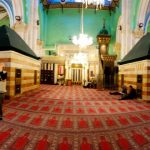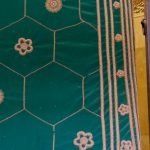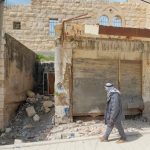The posts from 20-28 March 2014 were originally posts formatted for Tumblr. Click here to see the original blog.
Hebron is a difficult place, or at least it was for me. This is a very broken town. It’s streets bear the obvious signs of brokenness and war.
At the heart of Hebron are seven very significant tombs – or at least their representations. In the Cave of Macphela thought to be under Hebron lie, according to the Bible, the remains of Abraham and Sarah, Isaac and Rebekah, Jacob and Leah and Joseph. As patriarchs, Abraham the father of them all, these figures unite the three faiths that call themselves Abrahamic faiths, Judaism, Christianity and Islam. But here at their tombs there are all the signs of human divisions.
Look carefully at the middle picture in my vertical triptych above. The green silk is the edge of the tomb of Abraham as seen from the Synagogue forecourt. If you look through to the green grilled window beyond this opens directly into a Mosque – or rather, from the Mosque it give opportunity to see the tomb of Abraham. Now make out a grey frame filled with bullet proof glass alongside the tomb and between the windows. This is a most powerful symbol of fear between two cultures. The glass was installed by the Israelis after a Jew named Baruch Goldstein broke into the Mosque in 1994 killing 29 Muslim Palestinian worshippers and injuring 125 more. The glass stands in fear of reprisals and so a symbol of unity between world faiths points more sharply instead to fear.
Still, the Mosque and the Synagogue continue to share the tombs in some uneasy fashion. You cannot walk from one straight into the other but have to take a great circular walk around the outside passing through a check point and a security scan. The two places of worship stand within a wall built by Herod the Great to enclose the site over 2000 years ago. It is the only place in the Holy Land with any credibility as a last resting place for the Patriarchs. Whilst it houses a Synagogue and a Mosque there is no Christian Church here. The Christian Church does not have a feast day commemorating the Patriarchs and so no Christian worship takes place on the site. Christians are, however, allowed to enter both Mosque and Synagogue – Jews and Muslims cannot do so. Top of the triptych is a panoramic image from inside the Mosque itself. The pitched roof construction on the left is the Mamluk built tomb of Leah and on the right that of Isaac.




